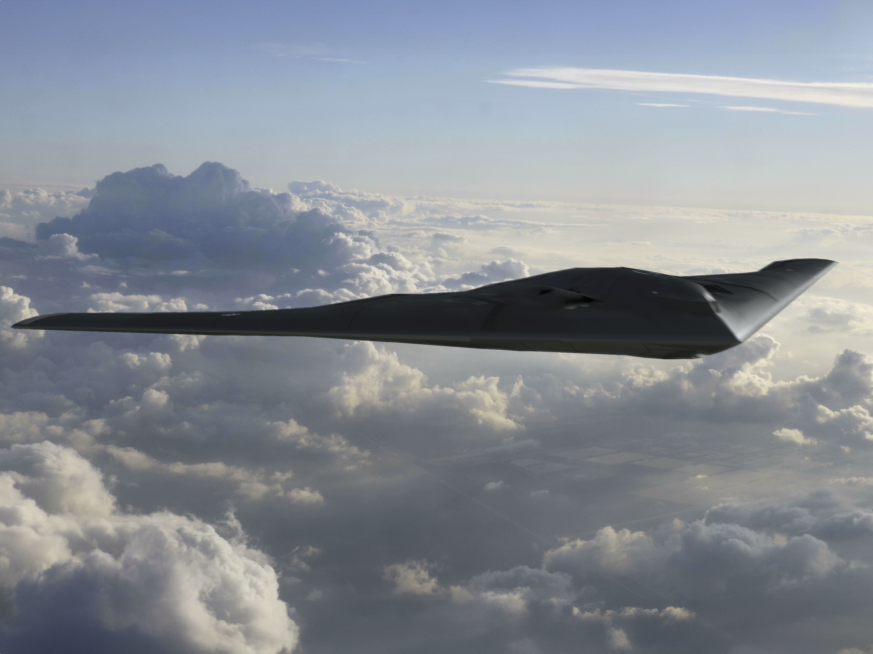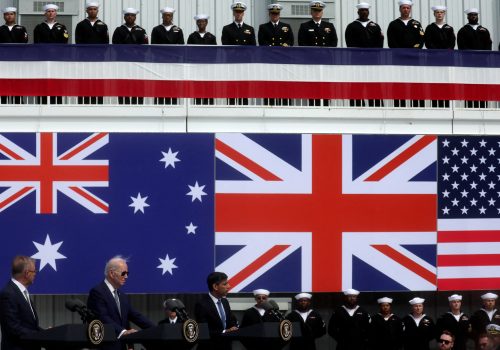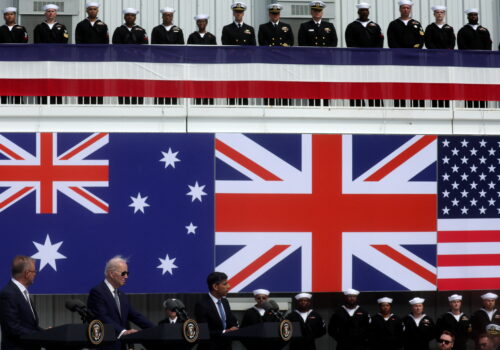Making AUKUS work: The case for an Indo-Pacific defense innovation consortium
Now well into its fourth year, the Australia-United Kingdom-United States (AUKUS) security partnership remains many months away from rapidly delivering advanced capability to the Indo-Pacific. Notwithstanding its prominent place in Washington’s ambitions to design a “hellscape” for China in the region, AUKUS has continued to focus primarily on assisting Australia in building a fleet of conventionally armed, nuclear-powered submarines—a long-term project that will take years, if not decades, to materialize. To bridge this gap, the AUKUS nations have concentrated on creating a seamless export environment for emerging and disruptive technologies with more immediate applications. AUKUS Pillar II, already intended to advance the joint development of advanced capabilities, should be better engineered to support advanced co-development, co-production, and co-sustainment quickly and effectively.
The reality of multilateral defense innovation cooperation, however, is that existing technology-sharing rules and a general lack of understanding of how to navigate the defense sector—both basic requirements for establishing a foothold in a tightly regulated market—remain significant barriers to enhanced industrial collaboration within AUKUS and beyond. In particular, the International Traffic in Arms Regulations (ITAR) and Export Administration Regulations (EAR), the US defense and dual-use technology-sharing regimes, continue to obstruct meaningful allied co-innovation despite reform efforts spanning the Obama, Trump, and Biden administrations. Even a much-touted new ITAR exemption for AUKUS, currently undergoing implementation, took years of lobbying and legislating to enact, and its ultimate impact remains uncertain, contingent on industry buy-in.
Even as the Trump 2.0 administration will likely continue restricting transfers of sensitive capabilities, these export barriers should not prevent the United States from acting swiftly—where clear win-win benefits exist—to enhance cooperation on high technology with key allies. With tensions rising over Taiwan, Washington has a substantial opportunity to advance this agenda in the Department of Defense’s priority region. While ITAR and EAR reform will take time, the Indo-Pacific offers fertile ground for collaboration, with its diverse—if disparate—network of technologists, companies, and investors eager to participate in defense innovation. The important groundwork of fostering relationships between commercial sellers and military buyers cannot and need not wait for these legal frameworks to catch up. These efforts must necessarily proceed in tandem with new export rulemaking and, indeed, would help justify and accelerate those legal changes. To seize this moment, a new mechanism is needed.
Enter the Indo-Pacific Strategic Partnership for Accelerated Research and Knowledge in Defense (SPARK). Inspired by and drawing from the best practices of ongoing NATO innovation efforts—which Rob Murray, one of this article’s authors, created and oversaw for a time—SPARK is our proposed Indo-Pacific initiative to actualize AUKUS Pillar II with dedicated capital and procurement vehicles. If properly constructed, SPARK will rapidly cultivate government relationships, institutional knowledge, and public-private investment pathfinders—critical lifelines for a small business or start-up seeking to navigate the capital-intensive defense innovation landscape.
For SPARK to achieve its potential, it will require strong backing from a wide array of public and private actors to meet the unique demands of its strategic environment. Despite its current limitations, AUKUS Pillar II already carries the broad political and institutional support necessary to grow a new regional effort, making it an ideal initial tether for SPARK and a launchpad for expanded Pillar II engagement with Japan, South Korea, and other key security partners. This new construct will enable Pillar II to establish new structures and incentives for innovators across the Indo-Pacific and facilitate the vast technology talent and capital flows already present in the region.
Growing priority, piecemeal approach
Defense technology has become a central regional priority amid China’s rapid expansion of its nuclear forces, naval fleet, and munitions stockpiles, as well as its continued provocations in the South China Sea. In 2023, the Department of Defense spent over $1.2 billion on partner capacity-building efforts in the Indo-Pacific, nearly a third of its entire international security cooperation budget. That same year, the Pentagon’s Pacific Deterrence Initiative was funded at a record $9.1 billion—$3 billion more than the original request to Congress. Buttressed by record-high foreign military sales driven by the war in Ukraine, US armaments cooperation in the Indo-Pacific has expanded accordingly.
Yet, despite these efforts, the lack of a unified Indo-Pacific defense innovation framework has become increasingly apparent. While various US-led efforts—such as the Quadrilateral Security Dialogue, Minerals Security Partnership, and informal Chips 4 Alliance—are slowly addressing this gap, no comprehensive approach exists to rapidly enhance strategic technology acquisition and investment in the Indo-Pacific. The Pentagon’s defense innovation partnerships with Japan, Singapore, and India are all important stepping stones toward greater cooperation, but these bilateral “defense tech bridges” remain fragmented and limited in scope. AUKUS Pillar II, despite its potential for expansion, still limits the involvement of key regional leaders, further restricting its impact. Currently, Washington’s new Partnership for Indo-Pacific Industrial Resilience (PIPIR) seeks to unite the region’s national armaments directors, adopting a similar approach to the Ramstein Group established within NATO after Russia’s full-scale invasion of Ukraine in 2022.
While encouraging, PIPIR’s efforts may dissipate unless a means exists to channel this momentum into concrete investments in immediately fieldable capabilities, alongside the longer-term AUKUS submarine effort (Pillar I). At present, US efforts to invest in Pillar II—though regarded as Washington’s flagship defense industrial cooperation effort in the Indo-Pacific—may not be up to the task of scaling development and production. The 2024 National Defense Authorization Act allocated $25 million for “AUKUS innovation initiatives,” while the Further Consolidated Appropriations Act of 2024 provided an additional $12.5 million for these initiatives, alongside $14.7 million for “AUKUS and coalition warfare” prize challenges. The President’s Budget Request for 2025 identified a further $79.8 million in research, development, test, and evaluation funds for AUKUS Pillar II—three times the 2024 budget. While these funds add some heft to the Pillar II project, the scale of investment needed to fully realize the transformative potential of these emerging technologies is vast, far exceeding current appropriations. To put these numbers in context, just in the first quarter of 2024, Alphabet, Apple, Microsoft, and Nvidia collectively spent $30 billion on research and development. Since 2021, the US defense technology sector has absorbed $130 billion in private venture capital. As it stands, AUKUS Pillar II lacks the sustained, comprehensive investment needed to fulfill its ambitious goals, risking significant delays in a climate where speed and scale increasingly determine success or failure. If the Indo-Pacific’s purse strings tighten permanently—after expanded military budgets are wasted on outdated or untested capabilities with few relevant uses—the United States may miss a critical opportunity for meaningful change. Failure to mobilize public and private networks around Pillar II now may risk a return to a more anemic, capital-scarce Indo-Pacific defense technology ecosystem—an outcome that SPARK could help arrest or entirely avoid.
Key priorities
To maximize its effectiveness, SPARK should serve as a catalyst for AUKUS Pillar II industry engagement, drawing on lessons from other alliance consortia—especially those with a proven record of fostering innovation. For instance, NATO’s Defense Innovation Accelerator for the North Atlantic (DIANA) and its sister initiative, NATO Innovation Fund (NIF), launched in 2022 and 2023, respectively, offer a promising model for this new Indo-Pacific framework. DIANA, which became operational in June 2023, seeks to accelerate technology adoption through a network of accelerators and test sites, as well as mentorship and grant opportunities. Meanwhile, NIF was established to provide long-term investment in deep-technology start-ups. With its comprehensive approach toward innovation, the DIANA-NIF model—adapted to the unique requirements of the Indo-Pacific—could galvanize public-private collaboration and innovation across a range of allies and partners. In particular, SPARK should emulate a few key aspects of the DIANA-NIF efforts:
First, SPARK should establish overlapping networks of accelerators and test sites aimed at both low- and high-technology and information-readiness-level partners. As with DIANA, this network should not be overly restrictive, stretching across the AUKUS nations and extending to other important industrial partners in the Indo-Pacific—especially Japan, South Korea, Canada, New Zealand, Singapore, the Philippines, and India.
Second, SPARK should adopt a set of enhanced mechanisms for continuous engagement between the private sector and potential military end users. Like DIANA, SPARK should host regular prize challenges in critical technology areas. Successful applicants to these SPARK challenges would receive access to initial grant seed funding, mentorship, and complimentary facilities before undergoing a second round of reviews to secure additional funding for transition assistance across the acquisition valley of death. Moreover, SPARK should assign a military expert to all successful applicants to ensure frequent and formal end-user engagement as their capabilities progress from prototype to production (idea to impact). While DIANA has begun to bridge this servicemember-technologist gap in NATO, its companies still have infrequent exposure to live end-user feedback. SPARK can avoid this shortcoming by establishing a formalized network of postings for military test and evaluation personnel.
Third, SPARK should strengthen this support by establishing its own rapid acquisition vehicle, designed to provide companies in priority areas with targeted assistance to scale production. Through targeted transition assistance in the form of matching government funding and commercial investment, this vehicle would emulate recent enhancements to the Pentagon’s commercial and dual-use technology procurement efforts, led by organizations such as the Defense Innovation Unit, Strategic Capabilities Office, and Office of Strategic Capital. Along with service-level innovation units like the US Air Force’s AFWERX and US Navy’s Disruptive Capabilities Office, these improved acquisition pathfinders have proven effective in unlocking new technologies for the US military. By implementing a similar combination of activities in the AUKUS+ context, SPARK would help introduce the Indo-Pacific defense industrial base to new contracting models with built-in flexibilities to accommodate today’s rapid innovation cycles and the private sector’s focus on commercialization.
Fourth, SPARK should create an Indo-Pacific Trusted Capital Marketplace where vetted investors can engage defense and dual-use technology start-ups aligned with regional security priorities. The SPARK investment arm should consider a two-track financing approach, building on US efforts to invest in strategic technologies while combating adversarial capital. Track one, inspired by NIF but focused on debt rather than equity, should provide capital-intensive loans and loan-based guarantees (as opposed to equity financing) with long maturity timelines and highly favorable lending terms necessary for deep technology research and maturation. Given the paucity of deep-tech loan financing for national security, a more attractive set of investment mechanisms, backed by the capital and credit of the United States and key regional allies, would fill a crucial gap and complement wider venture capital efforts. Track two, similar to DIANA’s Allied Capital Community, is a new effort intended to fulfill short-term investments for late-stage prototype development. It would cater to “impatient capital” and quickly move projects to operational status.
Finally, SPARK should establish a Joint Interoperability Center of Excellence. Without an alliance architecture resembling NATO, Indo-Pacific countries struggle to achieve and maintain interoperability with the US military, much less with one another. A center of excellence focused on this exact issue would help define the functional and performance requirements of systems operating within an Indo-Pacific coalition across a variety of specific contingencies. By enabling industry to better understand and meet the demands that will be placed on dual-use systems, this center would ensure that companies with little experience working alongside the military can develop into effective partners quickly.
Road map for adoption
The war in Ukraine has underscored the critical importance of rapid technological adaptation and the swift deployment of advanced capabilities, particularly in electronic warfare. Ukraine’s efforts to counter sophisticated Russian electronic warfare tactics with innovative, quickly developed solutions demonstrate the need for a defense framework that can respond rapidly to immediate threats and foster long-term technological advancement. Drawing on these lessons, SPARK should prioritize the development and deployment of electronic warfare systems, unmanned platforms, and cyber defense tools to ensure that Indo-Pacific forces can swiftly adapt to an evolving security environment.
To achieve this parity, SPARK must balance the rapid deployment and production of existing technologies with the development of new innovations. Initial priorities should focus on immediately impactful technologies such as unmanned systems, cyber defense, and secure communications. Longer-term projects should cover game-changing technologies, such as responsible artificial intelligence, quantum computing, and advanced materials. SPARK should operate on three strategic tracks:
- Rapid deployment track: Focus on quickly deploying mature technologies that are near operational readiness, ensuring they can be delivered to operators in the field as soon as possible.
- Innovation track: Concentrate on developing early-stage technologies that require more time to mature but hold significant future potential. This track will drive sustained innovation and technological superiority.
- Production track: Address the critical challenge of scaling production to meet urgent demands. This track will support and accelerate manufacturing capabilities, ensuring that new technologies can be produced at speed and scale.
Attracting private venture capital to SPARK will be crucial, particularly in aligning investment with mission-driven objectives rather than purely profit-maximizing strategies. The incentives for private capital should focus on profit optimization rather than profit maximization—emphasizing stable, long-term returns over short-term gains. Investors will be drawn to the opportunity to participate in projects with significant strategic importance, backed by government and military support, and the potential for steady, reliable returns over time.
To maximize effectiveness, SPARK should be structured as a cohesive entity that integrates research, development, testing, production, and investment under a unified governance framework. Unlike NATO’s DIANA-NIF model, where components function independently, SPARK’s unified structure will ensure seamless coordination across these tracks. It should be established as a regional consortium, open to Indo-Pacific nations beyond AUKUS, with a central management office overseeing operations. This office, potentially based in a neutral regional location, would enable rapid decision-making and coordination, supported by a rotating leadership structure and an advisory board comprising representatives from government, military, and industry sectors.
An Indo-Pacific SPARK would fulfill the glaring need for a unified innovation and technology acquisition framework in Washington’s most consequential arena of superpower industrial competition. A phased approach will be essential. In its first two years, through 2027, SPARK should focus on deploying mature technologies, enhancing production capabilities to meet immediate needs, and augmenting existing efforts such as the Replicator Initiative. Establishing accelerated production lines and leveraging private sector capacity will be critical in this phase. The subsequent phase will expand research and prototype development, guided by continuous feedback from end users. This integrated, multitrack strategy would ensure that SPARK can deliver immediate operational results while also securing long-term technological superiority, making it a cornerstone of regional security and technological collaboration tailored to the Indo-Pacific’s unique environment.
About the authors
Elliot Silverberg is the Director of Research at the Defense Innovation Board (DIB) in the US Department of Defense.
Jacob Sharpe is a Project Lead at the Defense Innovation Board (DIB) in the US Department of Defense.
Rob Murray is a nonresident senior fellow in the Forward Defense program and the Transatlantic Security Initiative within the Atlantic Council’s Scowcroft Center for Strategy and Security.
The views expressed are the authors’ and do not represent those of any organization or affiliation.
Related content
Explore the program

Forward Defense leads the Atlantic Council’s US and global defense programming, developing actionable recommendations for the United States and its allies and partners to compete, innovate, and navigate the rapidly evolving character of warfare. Through its work on US defense policy and force design, the military applications of advanced technology, space security, strategic deterrence, and defense industrial revitalization, it informs the strategies, policies, and capabilities that the United States will need to deter, and, if necessary, prevail in major-power conflict.
Image: Multinational ships sail in formation July 22, off the coast of Hawaii during Exercise Rim of the Pacific (RIMPAC) 2024. (US Navy photo by Mass Communication Specialist 2nd Class Evan Diaz)


